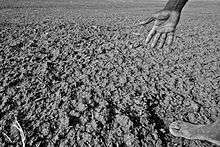Drought in India

Drought in India has resulted in tens of millions of deaths over the course of the 18th, 19th, and 20th centuries. Indian agriculture is heavily dependent on the climate of India: a favorable southwest summer monsoon is critical in securing water for irrigating Indian crops. In some parts of India, the failure of the monsoons result in water shortages, resulting in below-average crop yields. This is particularly true of major drought-prone regions such as southern and eastern Maharashtra, northern Karnataka, Andhra Pradesh, Odisha, Gujarat, Telangana and Rajasthan
History
In the past, droughts have periodically led to major Indian famines, including the Bengal famine of 1770, in which up to one third of the population in affected areas died; the 1876–1877 famine, in which over five million people died; and the 1899 famine, in which over 4.5 million died.[1][2] <for the first most affected >
Impact of El Niño
All such episodes of severe drought correlate with El Niño-Southern Oscillation (ENSO) events.[3][4] El Niño-related droughts have also been implicated in periodic declines in Indian agricultural output.[5] Nevertheless, ENSO events that have coincided with abnormally high sea surfaces temperatures in the Indian Ocean—in one instance during 1997 and 1998 by up to 3 °C (5 °F)—have resulted in increased oceanic evaporation, resulting in unusually wet weather across India. Such anomalies have occurred during a sustained warm spell that began in the 1990s.[6] A contrasting phenomenon is that, instead of the usual high pressure air mass over the southern Indian Ocean, an ENSO-related oceanic low pressure convergence center forms; it then continually pulls dry air from Central Asia, desiccating India during what should have been the humid summer monsoon season. This reversed air flow causes India's droughts.[7] The extent that an ENSO event raises sea surface temperatures in the central Pacific Ocean influences the degree of drought.[3] Around 43 per cent of El Niño events are followed by drought in India.[8]
See also
References
- Allaby, M (1998), Floods, Facts on File, ISBN 0-8160-3520-2.
- Allaby, M (2002), Encyclopedia of Weather and Climate, Facts on File, ISBN 0-8160-4071-0.
- Balfour, E (1976), Encyclopaedia Asiatica: Comprising Indian Subcontinent, Eastern and Southern Asia, Cosmo Publications, ISBN 81-7020-325-2.
- Burroughs, WJ (1999), The Climate Revealed, Cambridge University Press, ISBN 0-521-77081-5.
- Caviedes, C (2001), El Niño in History: Storming Through the Ages, University Press of Florida, ISBN 0-8130-2099-9.
- Chouhan, TS (1992), Desertification in the World and Its Control, Scientific Publishers, ISBN 81-7233-043-X.
- Collier, W; Webb, R (2002), Floods, Droughts and Climate Change, University of Arizona Press, ISBN 0-8165-2250-2.
- Heitzman, J; Worden, RL (1996), India: A Country Study, Library of Congress (Area Handbook Series), ISBN 0-8444-0833-6.
- Nash, JM (2002), El Niño: Unlocking the Secrets of the Master Weather Maker, Warner, ISBN 0-446-52481-6.
- Posey, CA (1994), The Living Earth Book of Wind and Weather, Reader's Digest Association, ISBN 0-89577-625-1.
- Singh, VP; Ojha, CSP; Sharma, N (2004), The Brahmaputra Basin Water Resources, Springer, ISBN 1-4020-1737-5.
Further reading
Citations
- ↑ Nash 2002, pp. 22–23.
- ↑ Collier & Webb 2002, p. 67.
- 1 2 Kumar KK; Rajagopalan B; Hoerling M.; Bates G; Cane M (2006), "Unraveling the Mystery of Indian Monsoon Failure During El Niño", Science, 314 (5796): 115–119, Bibcode:2006Sci...314..115K, doi:10.1126/science.1131152, PMID 16959975.
- ↑ Caviedes 2001, p. 121
- ↑ Caviedes 2001, p. 259.
- ↑ Nash 2002, pp. 258–259.
- ↑ Caviedes 2001, p. 117.
- ↑ "Preparing for a poor monsoon". The Hindu. 26 April 2014. Retrieved 27 April 2014.
External links
| Wikimedia Commons has media related to Atlas of India. |
- General overview
- "Country Guide: India". BBC Weather.
- "India Water Portal".
- "India—Weather and Climate". High Commission of India, London.
- Drought hit areas in Karnataka, in pictures
- Maps, imagery, and statistics
- "India Meteorological Department". Government of India.
- "Weather Resource System for India". National Informatics Centre.
- Forecasts